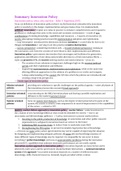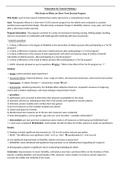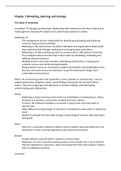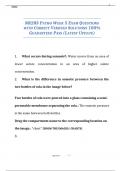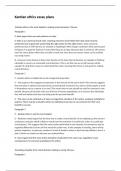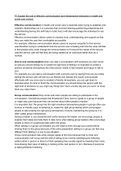Innovation policy: what, why and how - Edler & Fagerberg (2017)
Focus: (a) definition of innovation policy (what it is), (b) theoretical rationales (why innovation
policy is needed), (c) the design, implementation and governance (how it is implemented).
(a)WHAT: innovation = exploit new ideas in practice to enhance competitiveness and respond to
problems or challenges that arise in the social and economic environment → result of new
combinations of existing knowledge, capabilities and resources → 2 aspects of innovation: (1)
novelty (disrupting existing practices) and (2) implementation (adoption and exploitation).
→ Josef Schumpeter: introduced the distinction between invention (= a novel idea for how to do
things) and innovation (= carrying it out into practice (creative destruction).
→ narrow perspective: considering invention only → broader (holistic) perspective: looking at
the innovation cycle from the creation of novel ideas to their implementation and diffusion.
Innovation policy = government intervention that encourages and facilitates the generation,
application and diffusion of new ideas and provides direction to a firm’s innovation efforts →
styles: (a) proactive (IPR), (b) reactive (solving market and system failures) → focus on:
- The creation of new solutions to important challenges high on the societal/political
agenda and their exploitation and diffusion.
- Supporting experimentation, implementation and exploitation, while at the same time
allowing different approaches to the solution of a problem to co-evolve and compete.
- A deep understanding of the context (the NIS into which the policies are introduced) and
creating a long-term perspective.
→ 3 main types of innovation policy:
Mission-oriented providing new solutions to specific challenges on the political agenda → takes all phases of
policies the innovation process into account (broad approach).
Invention-oriented concentrating on the R&D/invention phase and leaving a possible exploitation and
policies diffusion to the market (narrower focus).
System-oriented focus on system-level features, such as the degree of interaction between parts of the
policies system, the extent to which a vital component is in need of improvement or the capabilities
of the actors → related to NIS.
(b)WHY: market-failure approach to innovation policy = market failure = underinvestment in
the creation of new knowledge (R&D) as what would be desirable for society → due to: (a)
uncertainty and (b) knowledge spillovers → 3 policy instruments to prevent market failure:
1. Investing in the public production of knowledge: in universities and other public research
organizations to safeguard innovations based on science in the future.
2. Subsidizing R&D in private firms: to induce firms to undertake more R&D.
3. Strengthening the IPR regime: to prevent incomplete legal protection of knowledge.
→ criticism: (a) vague policy advice (governments may not be capable of improving the situation
by designing and implementing adequate policies). (b) mixes info and knowledge (mastery of
many different types of knowledge may be required, it is impossible for one actor to know
everything = perfect knowledge). (c) focus on appropriability problems during the innovation
process (BUT, capabilities that underpin innovative performance are not easily copied).
Innovation-system approach to innovation policy = innovation depends on many factors and is
inherently multi-actor and the government should facilitate interactions → national innovation
system (NIS) approach = successful innovation depends on a number of different factors
(knowledge, skills, financial resources, demand), largely provided within a nation.
,→ conditions innovation policy at national level: (a) a holistic/systemic perspective, (b) sensitivity
to context and (c) transfer of policy from one national system to another is problematic.
Evolutionary economics = the balance between creation of new variety (invention/innovation)
and selection play a crucial role for long-run economic development.
→ selection processes: promote economic efficiency, but may give rise to path-dependency (make
it difficult to change course at a later stage) → FEX. due to monopolies in a market.
(c)HOW: policy instruments = policy instrument = a
government measure that aims to change the behaviour and
actions of the actors involved in the process from generating
new ideas into innovative market introductions and solutions →
15 major policy instruments (picture right).
→ innovation policy impact:
(a) it is challenging to assess the wider effects (on
innovation, productivity and jobs), as innovation is
difficult to measure.
(b) different policy instruments may interact, so it is
difficult to distinguish their individual effects.
(c) the impact of a policy instrument depends on a wider
innovation system into which it is introduced.
→ aligning interests of different actors by: innovation councils =
representatives of ministries, public research organizations,
businesses and NGOs that discuss guidelines for innovation
policy → increased involvement of non-state actors.
Objections for innovation policy: there is not always a market for innovation (imperfect
knowledge of future events) → Knightian uncertainty = can we invent it (how much R&D to
invest for a solution), can we make it (technical uncertainty, from invention to innovation, R&D) -
can we sell it (market uncertainty, from innovation to diffusion).
GL: Innovation policy in practice: a
researcher/advisor perspective - van der Veen
Innovation through a systemic model (picture left).
Policymaking is a cyclical process of issue identification,
agenda setting, policy formulation, policy mix
development and adoption, implementation and
evaluation and feedback → relevant unit of analysis is not
the individual but networks, clusters and institutions.
→ policy instruments: regulation, info and communication,
financial instruments → ideal government approach: make sure innovation is coherently
addressed by all parts of government → do this through STI councils = (a) promote innovation
and create policy synergies, (b) systematically monitor and report efforts and achievements, (c)
communication efforts and successes in parliament and society.
Redefining the Role of the State: What should it do? How should it do it? And How should
these decisions be made? - Stiglitz (1998)
Limitations to the extensive power of the state: (a) inability to make credible commitments. (b)
inability to adapt quickly to changing circumstances → government actions decrease social
, welfare or inhibit productive economic activity by taking resources away from one group and
giving it to another, often less deserving (imperfect info and incomplete markets).
→ libertarian view: all governments are bureaucratic, incompetent, rigid and counterproductive
and the solution is to get rid of the government in favor of private or market-based solutions.
Market mechanisms of the government to improve the private sector: (a) auctions for procuring
goods and services and allocating public resources. (b) contract out large portions of government
activities. (c) performance contracting. (d) design arrangements to use market info.
3 conditions for governments intervention: (1) societal interest, (2) no
one else will or can do it (no market for it), (3) the government is
able to do it → legitimation of policy (picture right) → FEX. bread →
1) causes food security, 2) is available in the market by supermarket,
3) so no government intervention is necessary → BUT, during WWII
there was a shortage and people were starving, then government intervention was necessary.
→ problems the market cannot solve: (R&D market failures and instruments to solve it)
Public goods = Externalities = Info Market power = Redistribution = FEX.
services provided goods produced for asymmetries ability of a firm to mandatory insurance pools, in
collectively that are private = FEX. the profitably raise which governments force the
(1) non-excludable consumption seller of a the market price community to contribute to
and 2) non-rival → benefit/harm third used car of a good/service insurance, which redistributes
FEX. street lightning parties → FEX. well knows about over marginal income from young to old (social
→ the market cannot educated staff → defects → costs → policy security) and from healthy to
provide this → policy policy instruments: risk capital, instruments: sick (medical insurance) → policy
instruments: R&D tax credits/ standards. competition law, instruments: innovation
research funding, subsidies. start-up support. vouchers, collaborative R&D
patents. programmes (PPP).
→ moral hazard = when a party to a contract can take risks without having to suffer
consequences → by rewarding people based on their level of income rather than individual
effort, the government discourages work → collective action problem = why invest in something
if the returns cannot be appropriated (free rider problems)?
→ negative externality = when firms create a negative value for society, without this being
reflected in their own costs and prices → policy response: developing standards, adjusting
business costs by incorporating societal damage, adjusting demand by creating transparency on
societal damage (green labels) → positive externalities (spillovers) = innovation-based value
benefitting other parties without full compensation.
→ knowledge spillovers = public good nature if not protected, causing imitation → policy
response: business R&D protection through patents and compensation (FEX. tax reliefs).
5 propositions for improving governance:
1. Restrict government interventions in areas where there is no evidence of a systematic,
significant influence of special interest.
→ limiting government action in areas where benefits of special interest legislation are limited →
difficulties: (a) existing interest groups won’t waive the rents they have gained. (b) abstinence
policies are difficult to maintain, (c) transaction costs create unforeseen problems in the future.
2. Motivate against government actions restricting competition and in favor of
government actions promoting competition.
3. Motivate in favor of openness in government and against secrecy.

